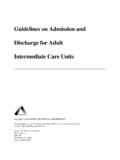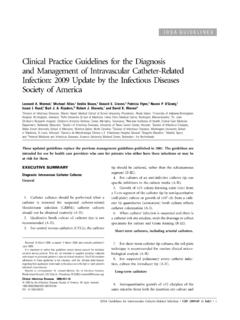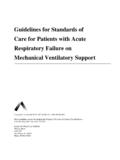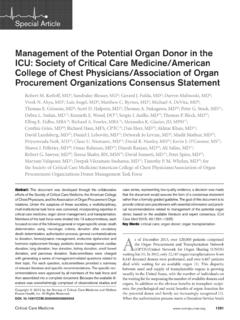Transcription of GUIDELINES FOR ICU ADMISSION, DISCHARGE, …
1 GUIDELINES for ICU admission , discharge , and Triage Copyright by the SOCIETY OF CRITICAL CARE MEDICINE. These GUIDELINES can also be found in the March 1999 issue of Critical Care Medicine -- Crit Care Med 1999 Mar; 27(3):633-638. Society of Critical Care Medicine 701 Lee Street Suite 200. Des Plaines, IL 60016. Phone: 847/827-6869. Society of Critical Care Medicine GUIDELINES for ICU admission , discharge , and Triage American College of Critical Care Medicine of the Society of Critical Care Medicine ABSTRACT. Appropriate utilization of Intensive Care Unit (ICU) resources is an important issue as the nation struggles to contain health care expenditures. The GUIDELINES proposed here provide models which ICUs may use in formulating admission , discharge and triage criteria. A process for implementation, monitoring and performance review of policies and procedures is also included. INTRODUCTION. The ICU concept prevalent today proliferated in the 60's (1-3).
2 The first Consensus Conference on Critical Care Medicine led by the National Institutes of Health (NIH) in 1983 pointed out that clinical practice has led to expanded indications for admissions to critical care units (4). Most physicians are of the opinion that the benefits of ICU care are unmeasured rather than uncertain (5). Because of the utilization of expensive resources, ICUs should, in general, be reserved for those patients with reversible medical conditions who have a "reasonable prospect of substantial recovery" (4-6). With recent changes in the health care environment, efficient use of ICUs has become a priority. Unfortunately, few studies have examined the indications for and the outcome of ICU care (7-10). Those that have, suggest that we may not be categorizing patients accurately. For example, Kraiss, et al. evaluated 196 patients undergoing carotid endarterectomy over a two-year period. There was no difference in outcome or complications between the group admitted to intensive care and those admitted to a general ward (8).
3 The Ethics Committee of the Society of Critical Care Medicine has previously published a consensus statement on triage (11). GUIDELINES for developing admission and discharge criteria were also proposed (12). The current document is a compilation and revision of the previously published GUIDELINES . Individual ICUs, using the GUIDELINES presented below, should create policies specific to their unit. Criteria for ICU. admission and discharge should be explicitly described. In addition, each ICU should define the scope of services it provides, and the patient population it serves, as approved by the professional staff. Specific circumstances under which the patients are admitted should also be defined (12-14). GUIDELINES and implementation policy should be written by a multiprofessional team. While the composition of the ICU Committee may vary, it should assure an adequate voice for those who regularly provide service to ICU patients, including respiratory care practitioners, nurses, physicians, and social workers.
4 The ICU Committee should review the policies of the intensive and intermediate care units. The Committee should also help educate the staff on admission / discharge /triage criteria, and efficient resource consumption. Policies written for admission , discharge , and triage should be reviewed on a regular basis and revised as needed. Revisions should be based on objective data. Compliance with the policy should be monitored in an appropriate forum, which in most institutions would be the ICU Committee. A policy should be in place for accommodating admissions when unit capacity is reached. Options may include limiting elective surgery or re-routing critical care admissions from the emergency department. Increasing the functional capacity of the ICU by boarding patients in other advanced care areas (assuming appropriate personnel and technological resources are available) may be an alternative to limiting services. 2. Society of Critical Care Medicine The admission , discharge , and triage criteria should also recognize patient autonomy, including advance directives, living wills, or durable powers of attorney for health care decisions.
5 It also should indicate who can admit patients to the ICU. Specific credentialing procedures should be in place. Levels of Recommendations for the Intensive Care Unit The Intensive Care Unit serves as a place for monitoring and care of patients with potentially severe physiological instability requiring technical and/or artificial life support. The level of care in an ICU is greater than that available on the floor or Intermediate Care Unit. Rating System Level 1: Convincingly justifiable on scientific evidence alone Level 2: Reasonably justifiable by available scientific evidence and strongly supported by expert critical care opinion Level 3: Adequate scientific evidence is lacking but widely supported by available data and critical care expert opinion 1. (Level 3) The Intensive Care Unit should have designated medical and nursing directors who are responsible for assuring appropriate patient triage through enforcement of patient admission and discharge criteria.
6 This triage must consider the needs of the patient and institution. 2. (Level 3) The physician and nurse directors should determine the limits of care, telemetry, mechanical ventilation and types of intravenous medications. 3. (Level 3) Intensive Care Unit Committee - A multiprofessional committee should be involved in developing and implementing the admission and discharge criteria. 4. (Level 2) The provision of intensive care improves the outcome of critically ill patients. 5. (Level 2) An intensivist-led multiprofessional team improves the outcomes of critically ill patients as measured by mortality, length of stay, and resource consumption. (15, 16). admission CRITERIA. ICU admission criteria should select patients who are likely to benefit from ICU care (2). Griner identified two conditions in which ICU care was of no greater benefit than conventional care (10). Situations involved patients who were at the two extremes of the risk of death spectrum; relatively low risk of death and exceedingly high risk of death.
7 These groups can be referred to as "too well to benefit" and "too sick to benefit" from critical care services. ICU care has been demonstrated to improve outcome in severely ill, unstable patient populations (17, 18). Defining the "too well to benefit" and "too sick to benefit" population may be difficult solely based on diagnosis (7, 19-24). For example, drug overdose patients are commonly admitted to an ICU. However, Brett et al. (19), demonstrated that patients without clinically determined high risk criteria never required ICU interventions. Nonetheless, 70% of these low risk patients were admitted to an ICU for observation. In addition to difficulties in determining the patient population who are too well or too sick to benefit, the specific criteria defining "substantial benefit" are subject to interpretation. For example, Paz, et al, examined admissions to the medical ICU following bone marrow transplantation. Bone marrow transplantation patients undergoing 3.
8 Society of Critical Care Medicine mechanical ventilation had an ICU discharge rate of only compared to a discharge rate of for those patients not requiring this therapy (21). Previous published reports documented similar poor survival rates for ventilator-requiring bone marrow transplantation patients ( to ) (22-24). Whether a to 7% discharge rate of bone marrow transplantation patients requiring mechanical ventilation is substantial or not may depend on the institution. These interpretations will lead to differences in admission criteria between institutions and physicians. Thus, it is recommended that ICU practitioners understand tools for assessing severity of illness and prognosis of critically ill patients. These instruments in conjunction with clinical judgement represent the best tools currently available to determine prognosis (11, 25-27). It should be noted, however, that in general, these predictive instruments have only been applied to patients already admitted to an ICU and have not been tested as preadmission screening tools.
9 The ICU admission decision may be based on several models utilizing prioritization, diagnosis, and objective parameters models. We wish to emphasize that these models are presented as GUIDELINES and individual institutions must create specific criteria to meet their special requirements. Prioritization Model This system defines those that will benefit most from the ICU (Priority 1) to those that will not benefit at all (Priority 4) from ICU admission . Priority 1: These are critically ill, unstable patients in need of intensive treatment and monitoring that cannot be provided outside of the ICU. Usually, these treatments include ventilator support, continuous vasoactive drug infusions, etc. Priority 1 patients generally have no limits placed on the extent of therapy they are to receive. Examples of these patients may include post-operative or acute respiratory failure patients requiring mechanical ventilatory support and shock or hemodynamically unstable patients receiving invasive monitoring and/or vasoactive drugs.
10 Priority 2: These patients require intensive monitoring and may potentially need immediate intervention. No therapeutic limits are generally stipulated for these patients. Examples include patients with chronic comorbid conditions who develop acute severe medical or surgical illness. Priority 3: These unstable patients are critically ill but have a reduced likelihood of recovery because of underlying disease or nature of their acute illness. Priority 3 patients may receive intensive treatment to relieve acute illness but limits on therapeutic efforts may be set such as no intubation or cardiopulmonary resuscitation. Examples include patients with metastatic malignancy complicated by infection, cardiac tamponade, or airway obstruction. Priority 4: These are patients who are generally not appropriate for ICU admission . admission of these patients should be on an individual basis, under unusual circumstances and at the discretion of the ICU Director.











